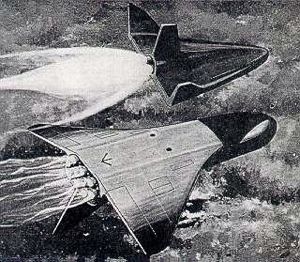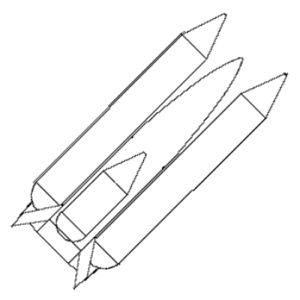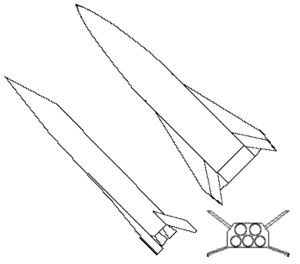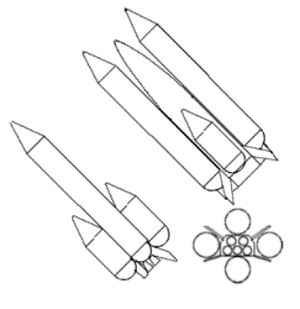
Home - Search - Browse - Alphabetic Index: 0- 1- 2- 3- 4- 5- 6- 7- 8- 9
A- B- C- D- E- F- G- H- I- J- K- L- M- N- O- P- Q- R- S- T- U- V- W- X- Y- Z
Shuttle MDC
 Shuttle MDC Credit: NASA |
Status: Study 1969. Thrust: 19,213.40 kN (4,319,344 lbf). Gross mass: 1,578,231 kg (3,479,403 lb). Height: 71.00 m (232.00 ft). Diameter: 8.00 m (26.20 ft).
Both the booster and orbiter would be towed horizontally to the pad, then tilted vertically and mated on the pad. The entire vehicle would lift off vertically, with the orbiter separating at 64 km altitude and 9800 kph. This staging velocity was slightly lower than that of the North American Phase A concept since the McDonnell Douglas orbiter had a slightly higher propellant mass fraction due to its lightweight design.
The booster stage was a delta-winged vehicle, 59.5 m long, powered by ten Pratt & Whitney 188,000 kgf engines. The 15% thick wing included fuel tanks for the JP-4 fuel for the turbojet fly back engines. The liquid oxygen tank was positioned forward to minimize engine gimbal requirements during boost. The heat protection system consisted of titanium structural panels, with Rene-41 shingles on the hottest areas.
The orbiter was a lifting body using the HL-10 shape, 32.6 m long, powered by two 188,000 kgf engines, with the payload bay at the center of gravity. A two-man crew would fly the orbiter. The orbiter's main engines would shut down at an altitude of 80 km, putting the vehicle into an initial 80 x 185 km orbit. They would be restarted at 10% thrust at apogee half a world away, circulizing the orbit at 185 km. The liquid oxygen tanks were forward, and three liquid hydrogen tanks aft. All the tanks were integral with the orbiter structure. Re-entry would be at a -1.5 deg flight path angle, at 50 deg angle of attack held until the lower fuselage reached 1200 deg C. Then the lifting body's bank angle controller would turn the vehicle to ensure that the 1200 deg C temperature would not be exceeded. In order to achieve the 725 km maximum cross range specified, the lifting body would bank after re-entry but while still travelling between 7400 and 4500 kph. The all-metallic thermal protection system used materials as appropriate to the heating rates on each portion of the external surface - titanium, Rene-41, nickel-chromium, with columbium-752 shingles on the hottest areas. For ferrying of the orbiter on earth, a special wing with 2 x 10,000 kgf TF39 turbofans would be bolted into the payload bay.
McDonnell Douglas estimated the total development program would cost $ 5.946 billion and be completed in 21 months (!) This would include production of two orbiters and two boosters. For operations a fleet of three orbiters and two boosters would be used. Assuming 12 flights were made per year, delivery cost to orbit would be $54 per kg. At a 100 flight per year rate, this would drop to $30 per kg. The preferred launch site was McConnell AFB, Kansas.
Flyaway Unit Cost 1985$: 48.000 million.
Stage Data - Shuttle MDC
- Stage 1. 1 x Shuttle MDC-A-1. Gross Mass: 1,242,630 kg (2,739,530 lb). Empty Mass: 220,254 kg (485,576 lb). Thrust (vac): 18,956.000 kN (4,261,478 lbf). Isp: 442 sec. Burn time: 230 sec. Isp(sl): 392 sec. Diameter: 8.00 m (26.20 ft). Span: 46.04 m (151.04 ft). Length: 59.45 m (195.04 ft). Propellants: Lox/LH2. No Engines: 10. Engine: SSME Study. Status: Study 1969 November. Comments: Delta winged configuration.
- Stage 2. 1 x Shuttle MDC-A-2. Gross Mass: 335,601 kg (739,873 lb). Empty Mass: 73,442 kg (161,911 lb). Thrust (vac): 3,070.400 kN (690,253 lbf). Isp: 459 sec. Burn time: 379 sec. Isp(sl): 359 sec. Diameter: 7.00 m (22.90 ft). Span: 23.08 m (75.72 ft). Length: 32.62 m (107.02 ft). Propellants: Lox/LH2. No Engines: 2. Engine: SSME Study. Status: Study 1969 November. Comments: HL-10 lifting body configuration.
Family: orbital launch vehicle, Winged. Country: USA. Engines: SSME Study. Stages: Shuttle MDC-A-1, Shuttle MDC-A-2. Agency: Douglas.
 | McDonnell 1969 McDonnell 1969 shuttle 160 pixels Credit: © Mark Wade |
 | McDonnell 1969 McDonnell 1969 shuttle orbiter Credit: © Mark Wade |
 | McDonnell 1969 McDonnell 1969 shuttle 3 view Credit: © Mark Wade |
Back to top of page
Home - Search - Browse - Alphabetic Index: 0- 1- 2- 3- 4- 5- 6- 7- 8- 9
A- B- C- D- E- F- G- H- I- J- K- L- M- N- O- P- Q- R- S- T- U- V- W- X- Y- Z
© 1997-2019 Mark Wade - Contact
© / Conditions for Use